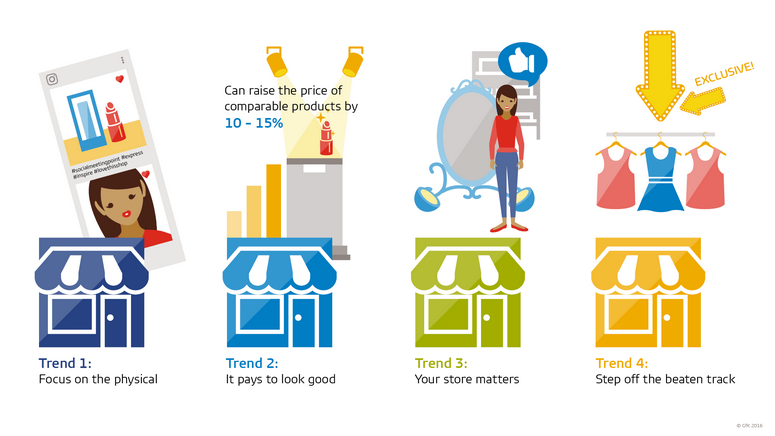BY MANUEL JAHN
What starts in the fashion and lifestyle sector typically spreads to other retail sectors, making it a useful barometer for the entire retail industry. In a recent white paper, we’ve identified trends that all retailers should keep an eye on.
The emergence of the “experience economy” underlines the importance of the physical retail environment. It’s no longer enough just to meet consumers’ concrete demands—their desire for a specific product or the lowest price. Retailers must satisfy the demands of the connected consumers of today for a variety of intangible qualities: rich, multi-faceted experiences. With shopping now an expression and extension of consumers’ lifestyles, retail venues must serve as social meeting points. Retailers need to create opportunities for consumers to express social, political and cultural interests through the act of visiting certain locations or purchasing particular items. Furthermore, they must inspire consumers and promote well-being.
It pays to look good
Product display is now an art form. Carefully presenting and showcasing products enables retailers to take back control of the purchase process from consumers and counter the prevailing trend of limitless availability. Encouraging consumers to spend more time per item leads to significantly higher conversion rates and can transform a store from a warehouse to a stage. Used successfully, this strategy can help to boost prices—data from the US indicates that retailers that employ this approach can raise the price of comparable products by 10% to 15%.

The store matters
Concept stores provide a key consumer touchpoint that continually inspires trust in the brand. Often focused on a certain theme, these stores guide consumers towards products that are consistent with their lifestyles. In these stores, the shopping experience matters just as much as the products. The atmosphere created by sales personnel and the style in which products are presented are every bit as important as the actual merchandise on sale. For consumers and retailers alike, experience, rather than price, becomes the preeminent concern.
Step off the beaten track
Stores are migrating from established shopping streets to trendsetting locations with higher creative potential. Pioneered by large sporting goods manufacturers, concept stores in trendsetting areas differentiate themselves by offering products not available elsewhere. These stores may not reveal their identities at first glance thanks to modified or fully altered store designations. Usually situated in mixed, concentrated, and highly-frequented surroundings, this is how they profit. Consumers in turn benefit from an enriched shopping experience that reflects their lifestyle orientation—a far cry from the usual pure material transaction associated with shopping.
The “experience economy” is the future
For the fashion and lifestyle sectors, as well as the retail sector at large, the “experience economy” will dominate the future. This is a world in which interfacing with consumers’ experiences and personal values is just as important as (and arguably more so than) supplying them with new products. In our work with retail clients around the world, we see a new push towards innovative physical retail concepts and locations as retailers seek to enhance the shopping experience for consumers.
New and reimagined real estate objects, shops, and location profiles will be required to satisfy consumer demand for mixed environments, interconnected usages and greater flexibility. The shift that has taken place in consumers’ expectations of the shopping environment and experience will not be reversed. Shopping is now both a lifestyle choice and a recreational activity. Retailers across the board must work hard to ensure that their offering in the new “experience economy” is one that lives up to consumers’ expectations.





